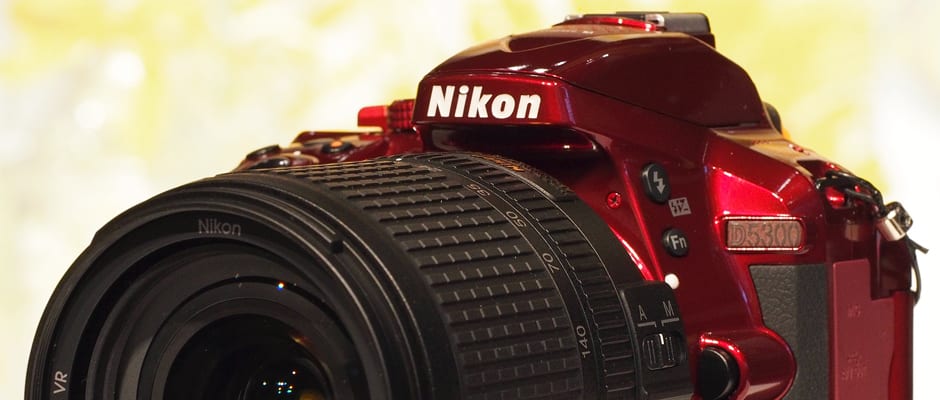Pros
Cons
Our First Take
It's no secret that we've been disappointed with some of the superficial improvements to sub-$2,000 DSLRs this year. While the industry's big players continue to develop remarkable professional cameras, they seem content to let brand recognition do the heavy lifting for consumer camera sales.
And then we met the Nikon D5300 (MSRP $799.95, body only). Nikon's latest mid-range model arrives less than a year after the company announced its popular predecessor, the D5200. At first glance, the D5300 may seem like a mere iterative upgrade, but a few key changes—namely a new kit lens and new sensor—have us intrigued.
Changes on the Outside
Despite minor changes, the outside looks very familiar.
At first glance, the D5300 looks like a doppelgänger to last year's D5200. What's new? Dyed-in-the-wool Nikon enthusiasts will notice that the company's designers have resculpted the grip, miraculously giving it more surface area while also increasing the clearance between grip and lens. The result is a definite improvement in handling; the camera is more comfortable to hold for long periods and feels well-balanced with the new 18–140mm kit lens.
Speaking of the new kit lens, Nikon is shipping the D5300 with only a single kit option: a new 18–140mm f/3.5-5.6G ED VR lens. The lens is already on sale separately for $599.95, and will cost that much as part of the kit as well (increasing the D5300 from $799.95 body-only to a whopping $1,399.95).
We spent some time shooting with the new lens and it seems to be a capable, versatile upgrade for current D5200 owners still shooting with their original kit lenses.
While we do like Nikon offering a beefier kit lens option, it puts the D5300 firmly out of reach for many entry-level photographers, especially considering that you can still get the D5200 for just $899.95 (with the admittedly inferior 18–55mm kit lens). Inscrutably, Nikon is also selling the D5200 with the new 18–140mm lens for $1,399.95... the same price it's charging for the D5300 kit. We assume that Nikon will drop the price on the D5200 when its successor hits store shelves later this month.
Nikon also squeezed in a smidge more real estate for its rear LCD: a 3.2-inch, 1.037m-dot articulating display—up from 3 inches and 921k dots on the D5200. Notably, Nikon has not blessed the D5300 with a touchscreen, while its chief competitor (the Canon T5i) was the second Rebel to get one. We're disappointed to see Nikon hold back there.
{{photo_gallery "tour"}}
Changes on the Inside
As with most things, it's what's inside that counts.
What really sets the D5300 apart is the changes Nikon has made under the hood. The star here is a new 24.2-megapixel CMOS sensor. While it's the same size as the sensor from its predecessor, the D5300 offers a tiny increase in resolution and a wider native ISO range of 100–12800 (expandable to 25600).
The most significant change in the sensor, however, is the removal of its low-pass filter. Judging from our experience with other filterless sensors, we expect the D5300 will deliver a small but noticeable increase in sharpness. Shots taken on the PhotoPlus show floor looked suitably sharp, but gazing at a photo on an LCD is no replacement for proper lab testing. We'll get back to you on this point shortly.
We can also safely assume that the revised sensor has been designed to play nice with the shiny new EXPEED 4 processor. Videographers can thank the EXPEED 4 for the D5300's 1080/60p video capability. We shot only a few short clips in our time with the camera, but we have high hopes for the improved video mode, given how impressed we were with the video performance of the D5200.
With an additional eye toward usability for the masses, Nikon has finally bestowed WiFi and GPS upon its SLR lineup. The D5300 will be the first Nikon SLR to carry these features, allowing users to share photos, perform remote shooting, and geotag their shots.
If you're concerned about the D5300's battery life, given all these new bells and whistles, Nikon has an answer: The D5300 touts a brand-new battery. Though the D5300 will be compatible with the older model's EN-EL14 battery, it will ship with the EN-EL14a, which is CIPA-rated for 600 shots—compared to 500 shots for the D5200. Of course, that rating doesn't include WiFi or GPS usage, but we welcome the increased life nonetheless.
Conclusion
A small, but intriguing step forward
If you were expecting revolutionary changes in Nikon's "advanced beginner" lineup... well, we're not sure why you were expecting that. The truth is, Canon and Nikon have been issuing superficial upgrades to their SLR lines for years. Given these reduced expectations, we were pleasantly surprised to see Nikon making some noteworthy changes for the D5300.
We wouldn't go so far as to proclaim the camera as a bold new beginning for Nikon, but the new, filter-free 24.2-megapixel sensor might actually prove beneficial to the D5300's image quality. What's more, the new 18–140mm kit lens (while expensive for many users), might actually be able to make use of the sensor's upgrade in sharpness.
As for the other improvements (WiFi, GPS, a new grip, and a marginally larger LCD), we doubt few but the most devoted Nikon fans will take notice. In fact, the new body color (a glossy gray, which replaces the D5200's "bronze") is probably the change that will get the most glances.
If the sensor fulfills its promise, the D5300 should represent an improvement on an already successful formula for Nikon. Given that, we expect that the D5300 will confidently step in to take over for the D5200 as a staple in Nikon's SLR lineup, and a hot seller this holiday season.
Meet the tester
Vice President of Editorial Management, Kaitlyn oversees the editorial departments of Reviewed.com’s various sites. She has been writing about technology since the turn of the century. Outside of her Reviewed.com home, Kaitlyn is also a theatre director and avid gamer.
Checking our work.
Our team is here to help you buy the best stuff and love what you own. Our writers, editors, and experts obsess over the products we cover to make sure you're confident and satisfied. Have a different opinion about something we recommend? Email us and we'll compare notes.
Shoot us an email


